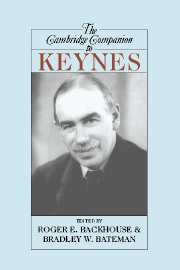Book contents
- Frontmatter
- 1 A cunning purchase: the life and work of Maynard Keynes
- 2 The Keynesian revolution
- 3 Keynes and the birth of modern macroeconomics
- 4 Keynes as a Marshallian
- 5 Doctor Keynes: economic theory in a diagnostic science
- 6 Keynes and British economic policy
- 7 Keynes and Cambridge
- 8 Keynes and his correspondence
- 9 Keynes and philosophers
- 10 Keynes’s political philosophy
- 11 Keynes and probability
- 12 The art of an ethical life: Keynes and Bloomsbury
- 13 Keynes and ethics
- 14 Keynes between modernism and post-modernism
- 15 Keynes and Keynesianism
- Bibliography
- Index
2 - The Keynesian revolution
Published online by Cambridge University Press: 28 November 2006
- Frontmatter
- 1 A cunning purchase: the life and work of Maynard Keynes
- 2 The Keynesian revolution
- 3 Keynes and the birth of modern macroeconomics
- 4 Keynes as a Marshallian
- 5 Doctor Keynes: economic theory in a diagnostic science
- 6 Keynes and British economic policy
- 7 Keynes and Cambridge
- 8 Keynes and his correspondence
- 9 Keynes and philosophers
- 10 Keynes’s political philosophy
- 11 Keynes and probability
- 12 The art of an ethical life: Keynes and Bloomsbury
- 13 Keynes and ethics
- 14 Keynes between modernism and post-modernism
- 15 Keynes and Keynesianism
- Bibliography
- Index
Summary
I believe myself to be writing a book on economic theory, which will largely revolutionise – not, I suppose, at once, but in the course of the next ten years – the way the world thinks about economic problems.
Keynes to George Bernard Shaw (quoted in Skidelsky 1992: 520)[A]n element of myth-making is involved whenever the phrase ‘Keynesian revolution’ is deployed . . . the rearrangement of ideas to which it refers was neither revolutionary in the usual sense of the word nor by any means uniquely Keynesian in origin.
(Laidler 1999: 3)INTRODUCTION
The Keynesian revolution is the central feature of twentieth-century macroeconomics. It has been praised, condemned and subjected to extensive historical analysis, sometimes being used as a case study in the philosophy of science. The aim of this essay is not to ask what the Keynesian revolution 'really' was, for that would be to add but one more turn to a debate that has continued for seven decades, but to explore how and why economists' understanding of the Keynesian revolution has changed in the seventy years since the publication of the General Theory. This is important for at least three reasons. It demonstrates some of the many ways in which Keynesian economics has been understood, for though there may be near universal agreement that there was, for good or ill, a Keynesian revolution, there has been little agreement over precisely what it comprised. It helps distinguish Keynes's economics from the 'Keynesian economics' of his successors; and it helps explain why it is superficially easy to use Keynes to illustrate propositions about the philosophy of science but very difficult to make such applications convincing.
- Type
- Chapter
- Information
- The Cambridge Companion to Keynes , pp. 19 - 38Publisher: Cambridge University PressPrint publication year: 2006
- 12
- Cited by

